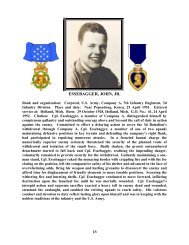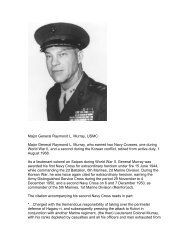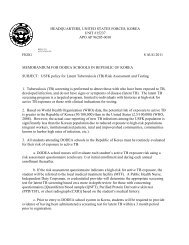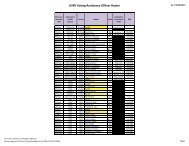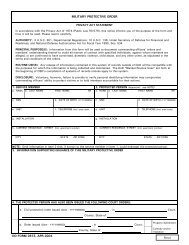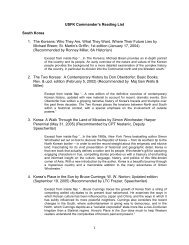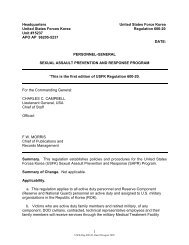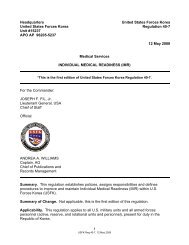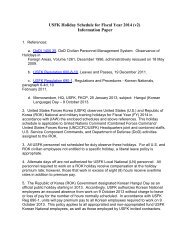Curtis Utz, Assault from the Sea, The Amphibious Landing, Naval ...
Curtis Utz, Assault from the Sea, The Amphibious Landing, Naval ...
Curtis Utz, Assault from the Sea, The Amphibious Landing, Naval ...
Create successful ePaper yourself
Turn your PDF publications into a flip-book with our unique Google optimized e-Paper software.
Storming Ashore at Red<br />
In this crescendo of exploding<br />
bombs, rockets<br />
and shells, Horace A. Bass,<br />
<strong>the</strong> control ship for Red Beach,<br />
gave <strong>the</strong> signal for assault.<br />
Coxswains in <strong>the</strong> eight<br />
LCVPs of <strong>the</strong> first wave<br />
gunned <strong>the</strong>ir engines and<br />
conned <strong>the</strong>ir boats across<br />
<strong>the</strong> line of departure. Corsairs<br />
strafing <strong>the</strong> beach<br />
rained 20mm shell casings<br />
on <strong>the</strong> sailors and Marines<br />
in <strong>the</strong> landing craft.<br />
<strong>The</strong> assault forces welcomed<br />
all of this extra firepower.<br />
<strong>The</strong> causeway on <strong>the</strong> right<br />
flank of Red Beach reminded<br />
Marine Captain Francis I.<br />
“Ike” Fenton, Jr., Commander<br />
of Company B, 1st Battalion,<br />
5th Marines, of <strong>the</strong> bloody<br />
World War II battle of<br />
Tarawa. Fenton considered<br />
<strong>the</strong> worst-if <strong>the</strong> enemy<br />
occupied <strong>the</strong> causeway “we<br />
were going to have a tough<br />
time making that last 200<br />
yards to <strong>the</strong> beach.”<br />
At 1731, <strong>the</strong> first LCVP<br />
hit <strong>the</strong> sea wall just ahead<br />
of <strong>the</strong> o<strong>the</strong>rs in <strong>the</strong> boat<br />
wave. Coxswains skillfully<br />
used <strong>the</strong>ir engines to hold<br />
<strong>the</strong>ir boats in place as Marines<br />
tossed grenades over <strong>the</strong><br />
wall. Amidst <strong>the</strong> explosions,<br />
ladders clattered against<br />
<strong>the</strong> rocks and riflemen<br />
scrambled “over <strong>the</strong> top.”<br />
NKPA machine gunners in<br />
<strong>the</strong> few bunkers still unsca<strong>the</strong>d<br />
sprayed <strong>the</strong> top of this rampart,<br />
cutting down some<br />
lea<strong>the</strong>rnecks and pinning<br />
o<strong>the</strong>rs near <strong>the</strong> sea wall. <strong>The</strong><br />
Marines had landed, but just<br />
barely.<br />
Nearby, a Navy coxswain<br />
rammed his LCVP into a<br />
breach in <strong>the</strong> sea wall. <strong>The</strong><br />
Marines stormed ashore<br />
right under a machine gun,<br />
fortunately silent, which protruded<br />
<strong>from</strong> a pillbox. This<br />
platoon <strong>from</strong> Company A<br />
quickly grenaded <strong>the</strong> position<br />
and six wounded Koreans<br />
stumbled out to surrender.<br />
<strong>The</strong>y rapidly cleared nearby<br />
trenches, advanced into town<br />
and secured <strong>the</strong> massive<br />
Asahi Brewery on <strong>the</strong> flank<br />
of Cemetery Hill. At <strong>the</strong> base<br />
of <strong>the</strong> Wolmi Do causeway,<br />
Company E occupied <strong>the</strong><br />
Nippon Flour Company<br />
compound.<br />
Not everything at Red<br />
Beach went so well. Most of<br />
Company A was pinned<br />
down and <strong>the</strong> second wave<br />
troops crashed in amongst<br />
<strong>the</strong>m. First Lieutenant<br />
Baldomero Lopez silenced<br />
one pillbox and moved to<br />
attack a second when an<br />
enemy burst hit him. Lopez<br />
fell on <strong>the</strong> grenade he was<br />
about to throw, sacrificing<br />
his life to save his men. <strong>The</strong><br />
NKPA gunners continued to<br />
fire, killing two more Marines.<br />
Company A finally destroyed<br />
<strong>the</strong> pillbox, but above <strong>the</strong>m<br />
loomed Cemetery Hill. <strong>The</strong>n,<br />
<strong>the</strong> platoon at <strong>the</strong> brewery<br />
attacked <strong>the</strong> back side of <strong>the</strong><br />
hill and captured several<br />
dozen dazed enemy infantrymen.<br />
<strong>The</strong>se victories had a<br />
cost; eight Marines lay dead<br />
on <strong>the</strong> little flat in front of<br />
<strong>the</strong> graveyard knoll and Navy<br />
corpsmen tended ano<strong>the</strong>r 28<br />
wounded lea<strong>the</strong>rnecks.<br />
Although <strong>the</strong> 5th Marines<br />
held Cemetery Hill, <strong>the</strong><br />
NKPA still threatened Red<br />
Beach. Observatory and<br />
British Consulate hills remained<br />
in enemy hands and<br />
until <strong>the</strong>y fell, Communist<br />
troops could fire directly<br />
into <strong>the</strong> landing area. It was<br />
especially critical that <strong>the</strong><br />
Marines on Red Beach take<br />
<strong>the</strong> high ground, because<br />
<strong>the</strong> assault waves would be<br />
followed by <strong>the</strong> LSTs loaded<br />
with ammunition, vehicles<br />
and supplies. Without this<br />
resupply, it was unlikely<br />
that <strong>the</strong> Marines could hold<br />
<strong>the</strong>ir positions overnight.<br />
<strong>The</strong> consolidation of Red<br />
Beach continued, but in<br />
ragged fashion. One passenger<br />
in <strong>the</strong> fifth wave, New<br />
York Herald-Tribune reporter<br />
Marguerite Higgins,<br />
remarked on <strong>the</strong> scene. She<br />
described a “strange sunset<br />
combined with <strong>the</strong> haze of<br />
flaming docks” which created<br />
a panorama “that a movie<br />
audience would have considered<br />
overdone.” Poor visibility<br />
contributed to a breakdown<br />
in coordination. <strong>The</strong> LCVPs<br />
of <strong>the</strong> fourth and fifth waves<br />
became intermingled and<br />
many touched land in <strong>the</strong><br />
wrong areas. <strong>The</strong>se boats<br />
carried <strong>the</strong> two infantry companies<br />
that were to seize <strong>the</strong><br />
most important position in<br />
Inchon, Observatory Hill.<br />
Hindered by battle smoke<br />
and a late afternoon drizzle,<br />
it took <strong>the</strong> two companies<br />
several minutes to reorganize<br />
ashore. One platoon and a<br />
mortar section, however,<br />
almost immediately struck<br />
out for <strong>the</strong>ir objective.<br />
Meanwhile, <strong>the</strong> eight<br />
LSTs destined for Red<br />
Beach maneuvered offshore.<br />
Each ship had embarked<br />
33



